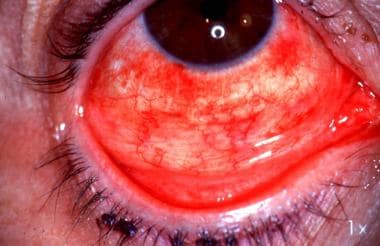Background
Epidemic keratoconjunctivitis (EKC) is a viral conjunctivitis caused by a group of adenoviruses. [1] This family of adenoviruses contains different serotypes that can also cause pharyngoconjunctival fever and nonspecific follicular conjunctivitis. EKC is highly contagious and has a tendency to occur in epidemics. It has been reported worldwide. [1] (See Etiology and Epidemiology.)
It is one of the most common causes of acute conjunctivitis, with characteristic clinical features such as sudden onset of acute follicular conjunctivitis, with watery discharge, hyperemia, chemosis, and ipsilateral preauricular lymphadenopathy. [1] (Follicular conjunctivitis is seen in the image below.)
Membranes and pseudomembranes can occur, with a distinguishing corneal involvement that ranges from diffuse, fine, superficial keratitis to epithelial defects to subepithelial opacities. Diagnosis is mainly clinical. Treatment is mostly symptomatic (cold compresses and artificial tears). Antiviral (cidofovir ) and cyclosporine eye drops were tried in some patients but without definite benefit. [2, 3] In cases with severe membranous conjunctivitis, mild topical corticosteroids can be used. (See History and Physical Examination.)
EKC is a self-limiting disease. It tends to resolve spontaneously within 1-3 weeks without significant complications. (See History.)
In 20-50% of cases, corneal opacities can persist for a few weeks to months (rarely up to 2 y). This phenomenon can significantly decrease visual acuity and cause glare symptoms. Excimer laser phototherapeutic keratectomy (PTK), along with low-dose mitomycin, can be used to remove subepithelial opacities. [4]
In rare cases, conjunctival scarring and symblepharon can occur secondary to membranous conjunctivitis. (See Physical Examination.)
See the following for more information:
Patient Education
For patient education information, see the Medscape Ophthalmology page, as well as Acute Conjunctivitis (Pink Eye) and How to Put in Eye Drops.
Etiology
More than 50 serotypes have been isolated, and at least 19 documented serotypes cause epidemic keratoconjunctivitis (EKC). The most commonly associated serotypes include adenovirus 8, 19, and 37, and, less frequently, serotypes 2-5, 7, 9, 10, 11, 14, 16, 21, and 29. Because of low natural immunity against adenovirus in the general population (eg, adenovirus type 8 antibodies are found in < 5% of the general population in the United States), every individual is considered to be susceptible to infection.
EKC epidemics tend to occur in closed institutions (eg, schools, hospitals, camps, nursing homes, workplaces). Direct contact with eye secretions is the major mode of transmission. Other possible methods of transmission are air droplets and possibly swimming pools. Adenovirus can be recovered from the eye and throat for as long as 14 days after the onset of clinical symptoms.
The role of the medical profession in spreading the disease is well documented in the literature. Many epidemics have been initiated in ophthalmology outpatient clinics by direct contact with contaminated diagnostic instruments. Reasons behind the infectious transmission of EKC in hospitals and clinics include the fact that: (1) the virus (adenovirus type 19) remains viable for 5 weeks; (2) the virus is resistant to standard disinfectants, such as 70% isopropyl alcohol and ammonia; and (3) the virus sheds from the eye 3 days before and 14 days after symptom onset.
EKC in East Asia and other parts of the world is endemic and does not appear to be transmitted through medical intervention. Viruses were isolated from more than 50% of cases of viral conjunctivitis; adenovirus constituted 94% of them.
Epidemiology
The actual prevalence and incidence of epidemic keratoconjunctivitis (EKC) in the United States are unknown, because most cases are seen by general practitioners and optometrists. This infection does not have to be reported to any medical authority in the United States. The prevalence and incidence of EKC are also unknown internationally.
No sex predilection exists.
The infection is more common in adults, but all age groups can be affected.
-
Follicular conjunctivitis and subconjunctival hemorrhage.
-
Symblepharon secondary to epidemic keratoconjunctivitis.



